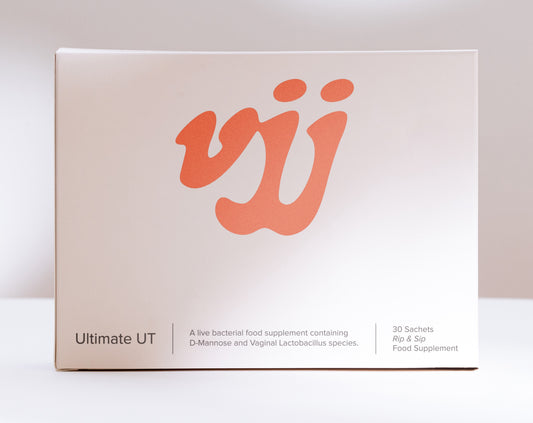The Vagina in Menopause.
Common complaints of women who are undergoing the menopause are related to vaginal health issues. Dryness, pain during sex, recurrent urinary tract infections and more often than not, increased bouts of vaginitis (vaginal infection and irritation). What is causing these problems, and why does it happen during Menopause – to find out, we need to look more generally at what is happening to our hormones at this time and how does this affect the vagina.
The menopause is described as that period after which menstruation, or periods stop. This is accompanied by a significant change in a woman’s hormone balance. The production of progesterone and oestrogen, the hormones which regulate our reproductive cycle (period), significantly reduce and it is primarily this loss of Oestrogen that causes problems.

In the run-up to menopause, the so-called ‘peri-menopause’, these hormones fluctuate as they head down to their new balance and it is this fluctuation that causes many of the early symptoms of menopause such as hot flushes, disturbed sleep and sometimes erratic emotional states. Our hormones are powerful shapers of our feelings, our emotions and our physical wellbeing.

The vagina experiences significant effects with the reduction of Oestrogen. One of the roles of this hormone is to maintain the health and vitality of an important layer of the vaginal wall – the Vaginal Mucosa. In a premenopausal healthy vagina, this thick layer of cells produces a wide range of important substances, from vaginal mucus, which keeps the vagina moist and lubricated to Glycogen and amino-acids which serve as food for a vital part of the vaginal ecosystem – the Vaginal Microbiome (VMB).
The mucosa is home to millions of microbes, good and bad bacteria and a range of yeast species like Candida (the yeast that causes thrush). The balance of this ecosystem is kept in check by a small variety of very special bacteria called Lactobacillus. These bacteria, specifically three types called L.crispatus, L.gasseri and L.jensenii are like the ‘guardians’ of the vagina. They ensure that the bad microbes that cause issues like thrush and bacterial vaginosis are kept in check. They also inhibit the transfer of bacteria from the anus to the urinary tract which may go on to cause UTIs/cystitis (most commonly caused by a faecal bacteria called E.coli).

The accepted definition of a ‘healthy’ vaginal microbiome, one that prevents imbalance causing infections is;
“A vaginal microbiome which is dominated by a few specific species of Lactobacilli which can metabolise glycogen to produce a range of anti-microbial compounds including Lactic acid and hydrogen peroxide and which in turn prevents the overgrowth of pathogenic microbes”
In layman’s terms, the good bacteria as described previously maintain an acidic environment which is hostile to bad bacteria and yeasts which cause infection. They do this by metabolising a substance in the vaginal mucosa called glycogen.
So where does oestrogen come into this picture?
Oestrogen influences the development and maintenance of the vaginal mucosa. As Oestrogen wanes during peri-menopause and menopause, the vaginal mucosa becomes thinner and is less able to support a healthy level of Lactobacilli which rely on it for their food. This has a number of consequences often called Vulvo-Vaginal Atrophy (VVA) or Genitourinary Syndrome of Menopause (GSM). This is characterised by the walls of the vagina becoming thin, dry, and sometimes inflamed. In many women, this leads to symptoms of vaginal burning, irritation, pain (especially during sex), bleeding, or discharge. Some women also have urinary symptoms, such as pain when urinating and needing to urinate more often than usual. Often women have many more UTIs and it is reported that the incidence of Bacterial Vaginosis rises with reduction on Oestrogen levels.
One interesting correlation is that vaginal pH increases as menopause progresses and in women of menopausal age is an indicator that their vaginal microbiome is less able to support important Lactobacilli and that vaginal atrophy is taking place.
There are many treatments available for vaginal atrophy from long lasting vaginal lubricants at the non-pharmaceutical end of the spectrum through topical vaginal oestrogen to Hormone Replacement Therapy.
Application or ingestion of oestrogen serves to maintain the vaginal mucosa, providing an ideal environment for the gatekeepers of vaginal health, the three Lactobacillus species to thrive and is associated with a significant reduction on urinary tract infections.
Recent publications are showing that consistently taking a probiotic supplement containing the vital Lactobacillus species can improve the health of the vagina and urinary tract as measured by the incidence of UTIs even in the absence of oestrogen, for example in women who have oestrogen blocking therapy for certain breast cancers.
The theory behind this is that constant replenishment of Lactobacillus by oral supplementation maintains a level of lactic acid producing bacteria sufficient to reduce colonisation of the vagina and urinary tract with pathogenic microbes such as E.coli.
The relationship between oestrogen, the vaginal mucosa and the vaginal microbiome is a complex and interdependent system designed to keep the vagina healthy, comfortable and free from infection.
There are simple and inexpensive steps that menopausal women can take to potentially reduce the symptoms of Vaginal Atrophy.
- Taking Oestrogen topically or as an HRT regime if possible
- Taking a daily supplement containing the three key Lactobacilli. crispatus, L.gasseri & L.jensenii. These are the constituent ingredients of the award-winning and patented probiotic from VJJ Health called Ultimate V.



